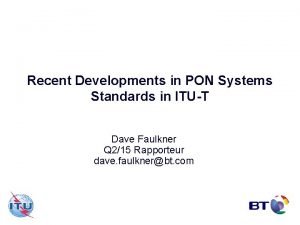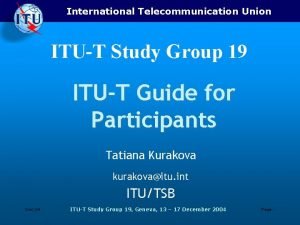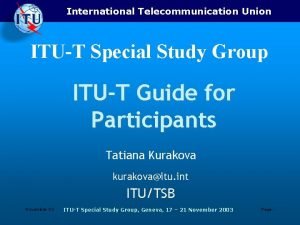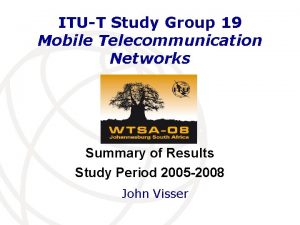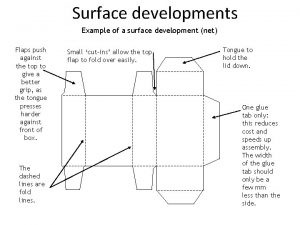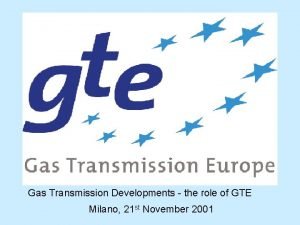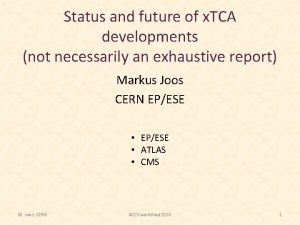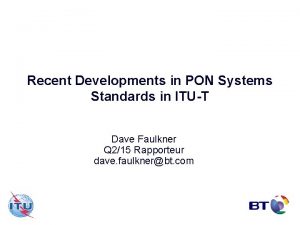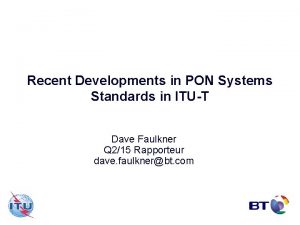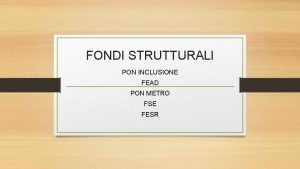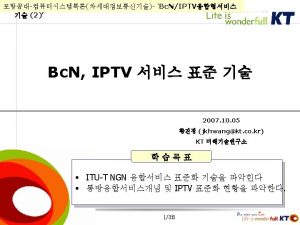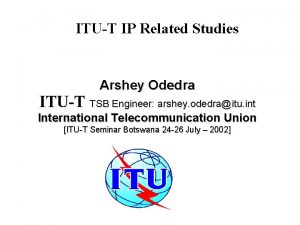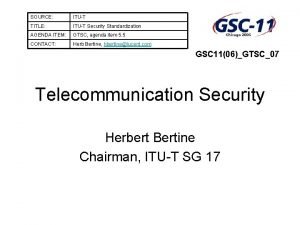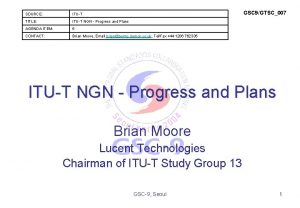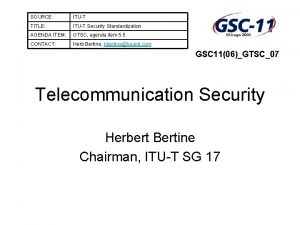Recent Developments in PON Systems Standards in ITUT























- Slides: 23

Recent Developments in PON Systems Standards in ITU-T Dave Faulkner Q 2/15 Rapporteur dave. faulkner@bt. com

Contents • • • The Role of the ITU in Standardization ITU-PON Access System Fixed Access Timelines Fiber Access Systems B-PON G-PON Recent Updates to B-PON and G-PON standards Outlook Conclusions

The Role of the ITU in Standardization • The International Telecommunication Union (www. itu. int), – headquartered in Geneva, Switzerland, – within United Nations System – governments and the private sector members coordinate global telecom networks and services. – ITU-T Recommendations, such as G. 982 (PON), G. 983. x (Broadband. PON) and G. 984. x (Gigabit-PON) are agreed by consensus and provide a framework for the implementation. – Question 2 on “Optical systems for fiber access networks” is the focus of activity for PON systems in the ITU • From an operator's perspective, cost reduction is the key motivator for standards – Interoperability and second sourcing are also important for a de-risking the investment. • From a vendor's perspective it is the assurance that products will satisfy the needs of a world-wide market.

ITU-PON Access System

Fixed Access Timelines 10 G 1 G 100 M Bit 10 M Rate Investment/loss Region. 10 GBE Early introduction 1 GBE Of competitive 10 G-PON technology G-PON 100 M VDSL 2 DP for premium 20 M VDSL 2 Cab services 18 M ADSL 2 plus 8 M ADSL 1 M 100 k 56 k modem 10 k WDM/PON VDSL Plateau? ADSL Plateau? Profitable Region “Cash Cow” Technology ‘uncompetitive’ Migration to new technology or loss of market share 1 k Source: “Next generation Broadband in Europe: The Need for Speed” Heavy Reading Report, Vol. 3 No 5 March 2005 See Notes

Fiber Access Systems. BT Perspective • Fiber to the premises (P 2 P, from CO) – – Existing deployment for businesses over 3 km and 2 Mbit/s Incremental deployment has high cost and long ‘lead’ times Churn leads to stranded assets Duct network insufficient for ubiquitous coverage • While copper stays in place • Fiber to the cabinet/VDSL 2 – – In BT trials Reuse of copper offers lower Cap. Ex than FTTP Op. Ex costs under investigation in trials Capacity is reach dependent • Subtended MSANs or Fiber could solve this • CO fed fibers are most likely to be used • Fiber to the premises (PON) – G-PON (e. g. 2. 4/1. 2 Gbit/s), favoured for limited use in 21 CN – Lower Cap. Ex and Op. Ex than (P 2 P) if deployed over whole areas – PON/OLT can act as a traffic concentrator (Qo. S, possible)

Active Optical Networks (P 2 P from COs/Cabs) - an alternative to PON • AONs deployed in parts of Europe by CLECs, approx 500 k subscribers • P 2 P can give more capacity than shared access systems – Better future-proofing • Upgrades – Only affect one customer – Require no changes to external plant • Shared access systems seem to date quickly – E. g. Cable systems are difficult to upgrade, outside plant needs changing – Shared access not needed with SDV (no broadcasting needed now) • Service and Network Management is a concern for operators/standards – Except SDH when used for direct connection to customers – G. 985 adds limited network management functionality to Ethernet over fiber

B-PON • Broadband passive optical network – – – based upon 53 byte ATM cells with mini-cells in transmission convergence (TC) layer Downstream ‘grants’ control the sending of upstream cells Rates up to 620 Mbit/s symmetrical • and 1240/622 asymmetrical have been standardised • Transport capability – – – native ATM TDM (T 1/E 1) by circuit emulation Ethernet by emulation • Business or home – 32 way split (some systems 64 way) – multi-casting possible • Standardised in G 983. x series in ITU

Business Drivers for PON

Broadband PON Frame Format Downstream Frame = 56 cells of 53 bytes PLOAM ATM Cell 1 ATM PLOAM ATM Cell 27 ATM Cell 54 Physical layer operations and maintenance (PLOAM) cells give grants to upstream ONUs. Maximum rate of 1/100 ms. Each contains 27 grants Upstream Frame = 53 cells per frame (aligned by ranging) ATM Cell 1 ATM Cell 2 ATM Cell 3 3 overhead bytes for guard time, preamble and delimiter ATM Cell 53

ONU Management and Control Interface • A management channel between OLT and ONU – Part of the baseband signal – Carried in the PLOAM cells • Physical layer operations and maintenance – Accessible by the Network Operator via the element manager on the OLT – Allows the PON and services to be configured and managed • Authentication, configuration and fault mangnet • Service management POTS, Video on demand, WLAN, VLAN, Ethernet – etc

Dynamic Bandwidth Allocation • A powerful conditional access mechanism – allows queues at the customer-ends of the PON to be served according to the priority assigned to the traffic flow – ranging from TDM circuit emulation through to best effort (using spare capacity). – also offers 'concentration on the fly', • statistical gain for packet-based services – likely to become increasingly important as users of IP begin to expect Qo. S-based services on congested networks • Allows bursts close to the maximum PON rate • Good for high speed packet transmission

B-PON Interoperability Events Where When Host Functionality Makuhari, Japan March 9 -11, NTT/FSAN meeting TC layer with Ethernet 2004 Geneva, Switzerland June 2 -4, 2004 ITU ‘All Star Workshop’ San Ramon, CA, USA Sept 27, 2004 SBC/FSAN meeting TC Layer with Ethernet Voice and fax services via GR-303 Chicago, USA June 7 -9, 2005 TIA/ITU, SUPERCOMM TC Layer with Ethernet Voice service via GR-303 H-D IPTV and optical RF Video

G. 983. 3 Enhancement Band • Downstream bands for B-PON – 1490 (basic band) , 1550 (enhancement band) • New laser was required for 1480 -1500 nm band • Enhanced services in 1539 -1565 nm band – e. g. for broadcast services • 1260 -1360 nm upstream band retained • Blocking filters and/or triplexer needed for ONT’s – To receive additional service wavelength(s) – e. g. 1480 1500 1539 1550 Receive -1. 5 Accept -20 Reject -30 d. Bm 1565

ITU-PON Showcase at SUPERCOMM

G-PON • Gigabit Passive Optical Networks – Higher capacities possible than B-PON – More efficient transmission of IP/Ethernet Cells – Same Optical Distribution Network

Service Requirements for G-PON.

Physical Layer Specifications for G-PON 2. 4/1. 2 Gbit/s emerging as most popular rates

Key Differences Between Gigabit- PONs Item MAC Layer PHY Layer FSAN / ITU-T G-PON IEEE GE-PON Service Full services (Ether, TDM, POTS) Ethernet data Frame GEM frame Ethernet frame Distance 10 / 20 km (Logical: 60 km) 10 / 20 km Branches 64 (Logical: 128) 16 or over Bit rate Up : 155 M, 622 M, 1. 25 Gbit/s Down : 1. 25 G, 2. 5 Gbit/s 1. 25 Gbit/s (Up and Down) Bandwidth Same as above (NRZ coding) 1 Gbit/s (8 B 10 B coding) Opt. Loss 15 / 20 / 25 d. B 15 / 20 d. B Wave-length Down : 1480 -1500 nm Up : 1260 -1360 nm Same (Available to video signals overlay) Upstream burst timing Guard : 25. 6 ns Preamble : 35. 2 ns (Typical) Delimiter : 16. 0 ns (Typical) Laser turn on / off : 512 ns (Max) AGC setting and CDR lock : 400 ns (Max)

Recent Updates to B-PON standards • Nov 2004 • G. 983. 1 Revised. ‘Broadband Optical Access Systems Based On Passive Optical Networks (PON)’ – Includes two previous Amendments, A Corrigendum, and Implementers’ guide • G. 983. 2 Amendment 2, ‘B-PON ONT Management and Control Interface (OMCI) support for Video Return Path’, – Facilitates the use of set-top boxes originally designed for cable networks • May 2005 • G. 983. 2 Revised ‘B-PON ONT Management and Control Interface (OMCI)’. – All documents on OMCI have been merged into this revision, G. 983. 2 and G. 983. 6 through to G. 983. 10 plus the Amendments 1 and 2 and Implementers’ guide. – New functionality includes mechanized loop testing for telephony and ‘last gasp’ reporting • G. 983. 3 Amendment 2, “A broadband optical access system with increased service capability by wavelength allocation” – Industry best practice optical budgets for the 622/155 B-PON system • • 28 d. B Optical Distribution Networks for B-PON 27 d. B with Analog video service • G. 983. 1 Amendment 1 on Protocol Implementation Conformance Statements (PICS) for the OLT and ONT. – To show that the devices conform with G. 983. 1 at the transmission convergence layer

Recent Updates to G-PON standards • May 2005 • G. 984. 3 Amendment 1 to G-PON Transmission Convergence Layer. – Peak Information Rate and Sustained Information Rate parameters are now included and are analogous to ATM for alternative cell lengths such as Ethernet packets. – Multicast services may now be supported over GEM (e. g. IPTV). – (GEM is the generic encapsulation mode use at in the transmission convergence layer) • G. 984. 4 Amendment 1 “Gigabit-capable Passive Optical Networks (G-PON): ONT Management and Control Interface specification”. – Proposes management features on G-PON in support of Ethernet and IPTV service such as the IEEE 802. 1 p priority mapper, GEM traffic descriptor, and support of multicast connection.

Outlook • Capacity doubling every year! – 1000 -fold increase in 10 years. – depends upon investment in new infrastructure, – Varies between country, region and location • Dependent on the economics and national strategy. • Can the life of G-PON be extended? – Bursting to 1 Gbit/s could buy 3 years (to 2016) • Upgrades – With the addition of new wavelengths and/or new fiber – Faster TDM-10 Gbit/s – WDM/PON

Conclusions • The B-PON and G-PON series of standards are largely complete – B-PON has reached maturity with up to eight vendors with interoperable OLT and/or ONU. – The FSAN/Interoperability Task Group promotes standards conformance and interoperability among vendors. • Recommendations in the G. 984. x series detail G-PON, the latest generation of PON technology. – Increasing capacity to Gigabit levels satisfies customer demands for capacity in the range 100 Mbit/s (dedicated) and 1 Gbit/s (shared) – G-PON maintains the same optical distribution network, wavelength plan as B-PON • offers more efficient IP and Ethernet handling • Next step is G-PON interoperability • The enhancement band is used by some operators to transport analog cable TV – In the future, as TV moves from RF-analogue to digital-in-band the enhancement band is expected to be used for two-way interactive digital services.
 Recent developments in ict
Recent developments in ict Recent developments in object detection
Recent developments in object detection Pon standards
Pon standards Itut
Itut Ittut
Ittut Itut
Itut Cabs itut
Cabs itut Cultural development of sahelanthropus tchadensis brainly
Cultural development of sahelanthropus tchadensis brainly Chartered developments
Chartered developments Political developments in the early republic
Political developments in the early republic Huron creek
Huron creek Political developments in the early republic
Political developments in the early republic Surface developments
Surface developments Transmission developments
Transmission developments In the colonial era developments such as the new england
In the colonial era developments such as the new england Target developments
Target developments Pattern of developement
Pattern of developement What are the two types of pattern development
What are the two types of pattern development Comtel atca
Comtel atca Democratic developments in england
Democratic developments in england Ska developments
Ska developments Name the figure
Name the figure Penthrox share price
Penthrox share price Donmeg developments
Donmeg developments


